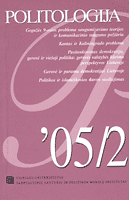Rusijos karinė doktrina: konvencinės ir branduolinės ginkluotės santykis
Russian Military Doctrine: A Balance Between Nuclear and Conventional Armament
Author(s): Kornelijus Sadauskas, Gražvydas JasutisSubject(s): Politics / Political Sciences
Published by: Vilniaus universiteto leidykla & VU Tarptautinių santykių ir politikos mokslų institutas
Keywords: conventional and nuclear forces of Russia; Russian military doctrine; Russian strategic nuclear arsenal; US foreign policy in general and strategic arsenal development policy in particular;
Summary/Abstract: The research has been devoted to investigate a level of readiness and capabilities of conventional and nuclear forces of Russia. The aim was to examine Russian military doctrine balancing between the use of conventional and nuclear armaments and to draw up the possible doctrinal modification or prospects. The article was divided into several parts covering the main features of Russian military doctrine, its conventional armament issues, the possible use of tactical nuclear weapons and its implications on arms control sphere, the condition of strategic weapons and its capabilities. These indicators were being investigated in terms of arms control, technical capabilities and possible threats to Russia. Quantitative and qualitative analysis of main theatre weapon systems: main battle tanks, helicopters, armored vehicles, artillery has been indicated declining Russia's capabilities to ensure its national security by conventional forces. Deplorable condition of conventional forces implies Russia's reliance on non-conventional weapons to ensure national security. Russia's willingness to rely more on nuclear forces (both tactical and strategic) was envisioned in the main documents of Russia's military doctrine. Russia has viewed its tactical nuclear weapons arsenal to be essential for compensating apparent weaknesses of conventional forces brought on by economic retraction; for upholding Russian status and prestige in the post-cold war world; for countering the threat of chemical-biologic weapons; for preventing localized regional conflicts and deterring strategic escalation; and for fulfilling roles in battlefield nuclear combat. At risk is the informal regime on tactical nuclear weapons created by unilateral, parallel statements by George Bush and Mikhail Gorbachev in September-October 1991 and slightly expanded by Boris Yeltsin's statement in January 1992. What is more, there were discussions in the United States and Russia about developing new classes of these weapons. (…)
Journal: Politologija
- Issue Year: 2002
- Issue No: 1 (25)
- Page Range: 74-94
- Page Count: 21
- Language: Lithuanian

